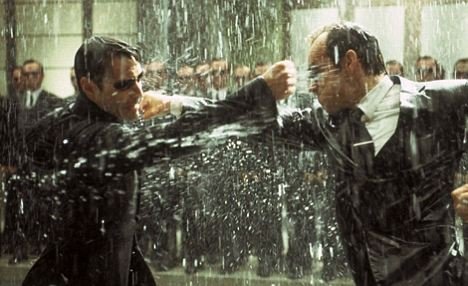優訊-中國網 china.com.cn/info 時間: 2011-12-12 責任編輯: 健兒

未來人們學習掌握一門新的技能將非常簡單,僅需要坐在電腦螢幕前,等待從大腦下載資料即可

未來人類可以像科幻電影《駭客帝國》中的故事情節一樣,甚至無須清醒狀態下也能讓大腦下載一些“知識技能”,學會武術、駕駛飛機、掌握一門新外語等。
騰訊科技訊(悠悠/編譯) 據英國每日郵報報道,日前,科學家宣稱,未來人類可以像科幻電影《駭客帝國》中的故事情節一樣,甚至無須清醒狀態下也能讓大腦下載一些“知識技能”,學會武術、駕駛飛機、掌握一門新外語等。
美國波士頓大學和日本京都ATR計算神經學研究室的科學家認為,未來人們學習掌握一門新的技能將非常簡單,僅需要坐在電腦螢幕前,等待從大腦下載資料即可。
科學家們正在研究如何使功能性磁共振儀(FMRI)通過大腦視覺皮層將學術資料下載至某人大腦中,這種發送的磁共振資訊可以改變他們的大腦活躍模式。該過程被稱為“解碼神經反饋(DecNef)”。
在解碼神經反饋傳輸過程中,接收者無需藥物輔助,甚至不必在清醒的狀態下亦能完成。接收者只要處於大腦活躍度中,經磁共振傳輸便能改變大腦目標模式,這些輸入資訊模式可能來自足球運動員或者是象棋大師。
美國波士頓大學的Takeo Watanabe是該研究報告作者,他説:“成年人的早期視覺皮層區域具有充分的可塑性,對視覺感知學習十分敏感。”
科學家之所以知道解碼神經反饋傳輸技術的有效性,是由於現已通過了志願者測試,結果表明比未接收該項治療的群體更具技能優勢。
在科幻電影《駭客帝國三部曲》劇情角色通過電腦物理性連接大腦,下載新的知識技能便能學習到新的知識技術。科學家表示,未來這種科幻劇情或將成為現實。這項研究結果將發表在近期出版的《科學》雜誌上。
http://big5.china.com.cn/info/2011-12/12/content_24126556.htm
Friday, December 9, 2011
科學家展示有如Matrix一樣的被動學習/Scientists demonstrate Matrix-like learning with no conscious effort
 |
| Source and Larger Version |
New research published today in the journal Science suggests it may be possible to use brain technology to learn to play a piano, reduce mental stress or hit a curve ball with little or no conscious effort. It's the kind of thing seen in Hollywood's "Matrix" franchise.
Experiments conducted at Boston University (BU) and ATR Computational Neuroscience Laboratories in Kyoto, Japan, recently demonstrated that through a person's visual cortex, researchers could use decoded functional magnetic resonance imaging (fMRI) to induce brain activity patterns to match a previously known target state and thereby improve performance on visual tasks.
Think of a person watching a computer screen and having his or her brain patterns modified to match those of a high-performing athlete or modified to recuperate from an accident or disease. Though preliminary, researchers say such possibilities may exist in the future.
"Adult early visual areas are sufficiently plastic to cause visual perceptual learning," said lead author and BU neuroscientist Takeo Watanabe of the part of the brain analyzed in the study.
Neuroscientists have found that pictures gradually build up inside a person's brain, appearing first as lines, edges, shapes, colors and motion in early visual areas. The brain then fills in greater detail to make a red ball appear as a red ball, for example.
Researchers studied the early visual areas for their ability to cause improvements in visual performance and learning.
"Some previous research confirmed a correlation between improving visual performance and changes in early visual areas, while other researchers found correlations in higher visual and decision areas," said Watanabe, director of BU's Visual Science Laboratory. "However, none of these studies directly addressed the question of whether early visual areas are sufficiently plastic to cause visual perceptual learning." Until now.
Boston University post-doctoral fellow Kazuhisa Shibata designed and implemented a method using decoded fMRI neurofeedback to induce a particular activation pattern in targeted early visual areas that corresponded to a pattern evoked by a specific visual feature in a brain region of interest. The researchers then tested whether repetitions of the activation pattern caused visual performance improvement on that visual feature.
The result, say researchers, is a novel learning approach sufficient to cause long-lasting improvement in tasks that require visual performance.
What's more, the approach worked even when test subjects were not aware of what they were learning.
"The most surprising thing in this study is that mere inductions of neural activation patterns corresponding to a specific visual feature led to visual performance improvement on the visual feature, without presenting the feature or subjects' awareness of what was to be learned," said Watanabe, who developed the idea for the research project along with Mitsuo Kawato, director of ATR lab and Yuka Sasaki, an assistant in neuroscience at Massachusetts General Hospital.
"We found that subjects were not aware of what was to be learned while behavioral data obtained before and after the neurofeedback training showed that subjects' visual performance improved specifically for the target orientation, which was used in the neurofeedback training," he said.
The finding brings up an inevitable question. Is hypnosis or a type of automated learning a potential outcome of the research?
"In theory, hypnosis or a type of automated learning is a potential outcome," said Kawato. "However, in this study we confirmed the validity of our method only in visual perceptual learning. So we have to test if the method works in other types of learning in the future. At the same time, we have to be careful so that this method is not used in an unethical way."
At present, the decoded neurofeedback method might be used for various types of learning, including memory, motor and rehabilitation.